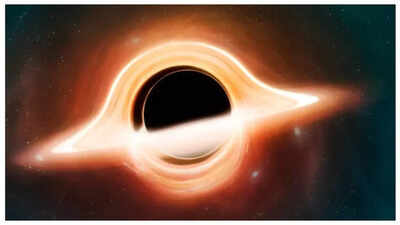Trending
NASA discovers massive black hole equivalent to 36 billion suns, hidden in space
Interestingly, this sort of magnification, known as gravitational lensing, was first predicted by Albert Einstein in 1915. According to new research now available, it is predicted as to how the LRG 3-757 obtains the mass required to bend light - from a giant, ultramassive black hole sitting right in its center
In an outstanding discovery, NASA astronomers have discovered a massive black hole that has a mass equivalent to 36 billion suns! Yes you heard that right. Here's more about the astronomical wonder...
How was the discovery made?
The astounding discovery was made at the Centre of Cosmic Horseshoe, a system of two galaxies in the Leo constellation. This places the discovery as one of the largest black holes ever recorded in history.
Discovered first in 2007, the Cosmic Horseshoe, as explained above, is a system of two galaxies in the constellation Leo. When one has a closer look at this system, images of it display a halo of light surrounding the galaxy, LRG 3-757. This phenomenon is known as an Einstein ring, and takes place when a big mass of the galaxy warps, and magnifies and reflects light from an even distant galaxy behind.
Predicted by Einstein in 1915
Interestingly, this sort of magnification, known as gravitational lensing, was first predicted by Albert Einstein in 1915. According to new research now available, it is predicted as to how the LRG 3-757 obtains the mass required to bend light - from a giant, ultramassive black hole sitting right in its center.
Coming back to Einstein's theory of relativity, it clearly explained that massive objects warp the fabric of the universe, called the space-time continuum. According to the late physicist, gravity was not caused by an unknown force, but rather by the space-time curving, and the distortation in the presence of matter and energy.
How did it happen?
By studying the intense gravitational lensing caused by LRG 3-757 — a galaxy with 100 times the mass of the Milky Way — along with the speed and pattern of stars orbiting it, the researchers concluded that an ultramassive black hole is "essential to simultaneously match both datasets."
This discovery places LRG 3-757’s black hole among the largest ever found. The largest known, Ton 618, is estimated to have a mass of 66 billion times that of the Sun and spans up to 40 times the distance between Neptune and the Sun. Meanwhile, the black hole at the center of the Holm 15A galaxy cluster weighs in at 44 billion solar masses and extends up to 30 times the distance from Neptune to the Sun.
Many unanswered questions
However, there are still some questions that remain unanswered. Scientists are still trying to decipher how this massive black hole was formed in the first place. However, the stars moving around it are slower than usual, and their movements are quite unpredictable, so to say. It is being assumed that this is happening, because some of the stars near it were ejected by old galaxy mergers, or the black hole swallowed many of the stars earlier, leaving little to no traces.
End of Article
FOLLOW US ON SOCIAL MEDIA
Visual Stories
Tired of too many ads?








